Thursday, December 31, 2009
Tuesday, December 29, 2009
The Story of Stuff
I first saw this last year about this time. The dawning of the new year seems to me a good time to keep the message in mind. Take 20 minutes out of your day to watch.
Posted using ShareThis
Tuesday, December 22, 2009
Tony
We believe the more people think and talk about responsibility, the more
the world becomes a better place.
If I hadn't had repeated nightmares about this happening to Lydia's Baby Boy over the years, I'd dismiss this movie immediately. It is predictable, boring and sappy. If you have the time, it's only 13 minutes wasted(Skip the credits and knock it down to 12.). Enjoy the warm, fuzzy feelings & Merry Xmas!
Tuesday, November 17, 2009
Sunday, November 8, 2009
November 10th Return to Offender Campaign - Veronica Chimes In & Charlie Responds
HA! I love your campaign. I've been mailing back junk mail in their return envelopes for years. While I salute you on your efforts, I don't think putting "Return to Offender" on the outside of the envelope is a good idea. It makes the companies' job a lot easier once they realize once going on. They will just throw away the envelopes. Instead, I suggest putting nothing on it, making this process a whole lot more painful. They'll have to sort it and process it, and open it, thinking there might be a filled out application inside. Maybe we should put the notice on the inside, writing "Return to Offender" on the last page inside the envelope, facing out.
Thanks for doing this and I will save my junk mail for November 10th. This is gonna be fun!
-Veronica Armstrong
Austin, Texas
Veronica,
Thanks for following up and for your suggestions. Its really good to see folks getting excited about this campaign. I like the idea of having the message on the inside. I also hear (and like) the idea of it being more painful for the companies to sort everything out first.
That said, having it on the outside does make for better "action pictures" for volunteers to send back to us and these 3 companies all already know they are being targeted for the Nov. 10th day of action.
To give you some insight into the inner workings of the DoNotMail campaign (and FE corporate campaigns in general) i wanted to take a minute to explain how we engage with the companies we're targeting.
Our approach to environmental change begins on the ground where we have staff members who live in the places we are fighting to protect and work with scientists to define critical regions. Once these regions have been mapped out, we determine which corporations are purchasing the products that cause those areas to be destroyed - i.e., the paper being produced to make Junk Mail.
When Then approach these companies, typically with an informational letter about the issue and request a meeting with them to discus things further. If a corporation refuses to change its practices, we hold that company publicly accountable--with protests, websites, email campaigns, national advertisements, and more. And when corporations are ready to protect forests and wild places, we help them implement sound policies through our Market Solutions.
Our Market Solutions department (formerly Corporate Action Program) helps companies distinguish themselves as environmental innovators and forest protectors. Tapping into both in-house expertise and an extensive external network, we provide information, guidance and recognition through a variety of mechanisms. These include direct consultation, business roundtables, sector scorecards and other published materials. We are also active in developing leading market standards and metrics.
In the case of the Return to Offender day of action each of the 3 companies we're asking volunteers to send junk mail back to have been contacted and have refused to discuss this issue with us. The companies have been informed that they are the targets of this upcoming day of action so (A) they are already awaiting people's letters and (B) they will know exactly why they're getting them.
ForestEthics will follow up with each of the 3 companies again a few weeks after the day of action and re-ask for a meeting to discuss our concerns. It's typically at this point where we can start to determine which companies are going to work with us without needing further pressure and which companies we may need to consider running longer campaigns against.
This is more or less how ALL our campaigns are run. For some examples of our past success stories please visit: http://forestethics.org/industry-success-stories
Hopefully this info was useful for you. I'd love to hear any further feedback.
charlie
Paper Campaigner - ForestEthics
Hope you are saving your junk mail more successfully than I am! Can you believe I haven't received a single mailing from one of these companies?! My junk mail has been solely comprised of x-mas catalogs. Too bad THEY don't come with a SASE... jen.
Friday, October 30, 2009
Fwd: CR's incredible dissolving bag
Sent to you by Melissa via Google Reader:
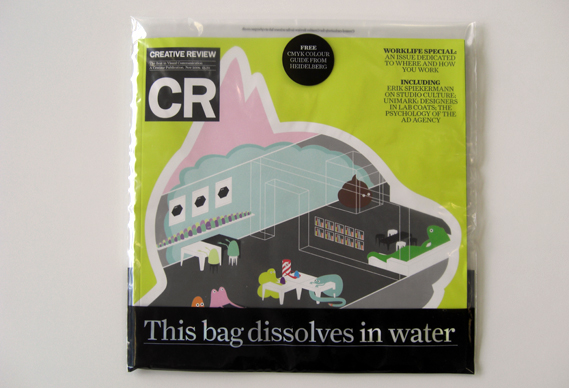
Newsstand copies of the November issue of CR come in a revolutionary new bag that simply dissolves in hot water. No waste. No landfill.
Anyone buying their copy of CR on the newsstand this month will find that the issue comes in a transparent bag bearing the words 'This bag dissolves in water'. And it does.

We are the first magazine anywhere to trial a new packaging material called harmless-dissolve which was created in the UK by Cyberpac. Here's what you do:
1, Take the magazine out of the bag

2, Cut off the sealing strip - the glue of the strip is biodegradeable but will not dissolve in water
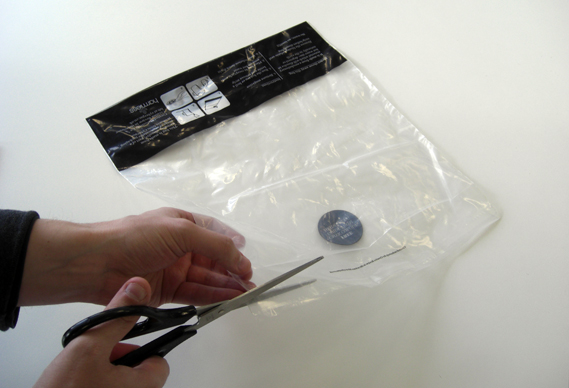
3, Place the bag in a receptacle filled with hot water (60+ degrees recommended by manufacturer)

The clear plastic dissolves into the water almost immediately

The printed area takes a little longer to break down - here's ours after about a minute

After a couple of minutes, the printed area has broken down sufficiently for it to disintegrate when rubbed between finger and thumb – it's a bit gunky and sticky but washes off straightaway


4, Pour the residue down the drain
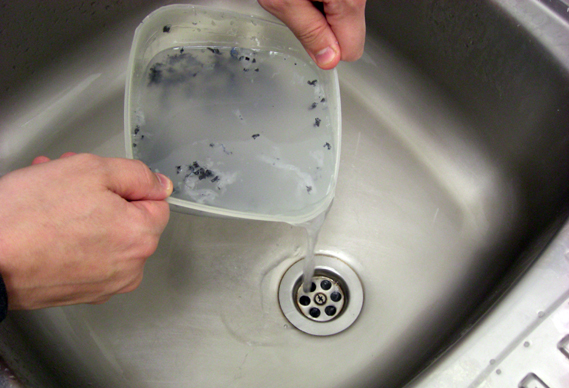
We are assured that any residue is perfectly harmless. Apparently you can even drink it - we tried, it tastes horrible, so we wouldn't recommend this.
A quick sluice around with water clears up any remaining residue both in the sink and in the receptacle.
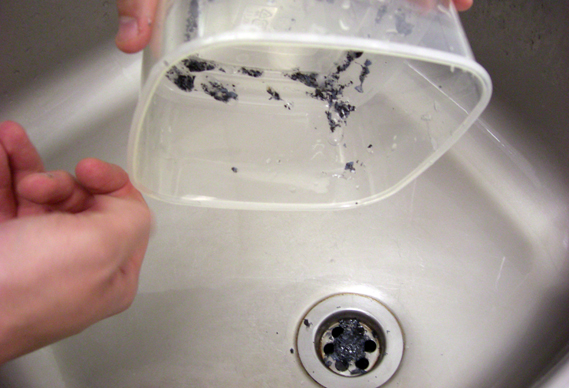
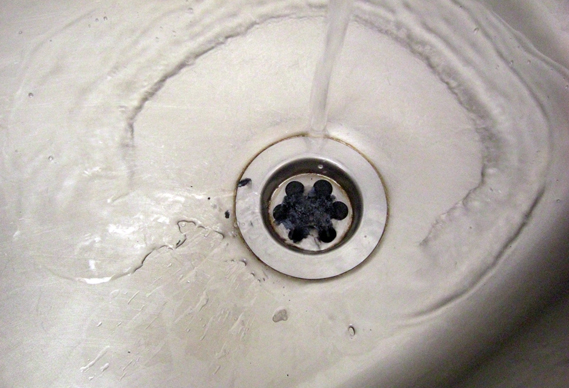
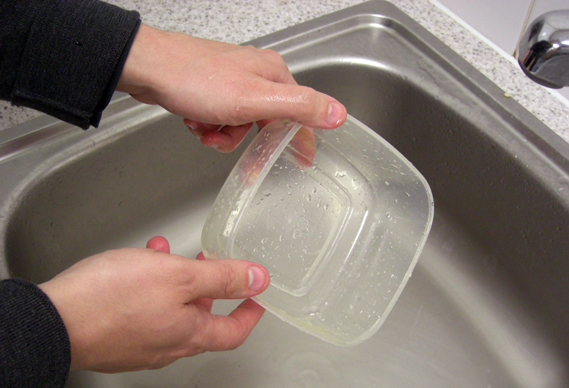
CR is working with Cyberpac on a range of experimental packaging solutions. Subscribers received our September issue in an envelope that could be re-used as a binder for our Monograph series (see here), while in October we gave subscribers one of six static prints of images from the Photography Annual (see here).
Why do a bag at all? We needed to bag this month's issue on the newsstand because it contains a free CMYK colour guide from Heidelberg. Rather than using a traditional polybag, we tried this. If subscribers would like one of the colour guides, please contact aminah.marshall@centaur.co.uk and we will send you one.
Subscriber issues come in regular, non-dissolvable, packaging this month - next month, though, we have something special for you.
UPDATE
More details from Cyberpac on how it works, also in the comments below: "The hot water is just to show you the biodegradability at speed. You don't need to boil it, just chuck it on the compost heap! We use this to package fish food as it dissolves in the water releasing the bait.
"Harmless-Dissolve is made from a hydro-degradable substrate which is 5 times stronger than normal polythene. It is a readily biodegradable, water soluble polymer which completely biodegrades in a composting environment, in a dishwasher or in a washing machine. It has no harmful residues and will biodegrade into naturally occuring substances - the bugs love it.
"It's non-toxic and is degraded by micro-organisms, moulds and yeasts. These organisms can occur in both artificial environments, such as anaerobic digesters, activated sewage sludge and composts and natural environments such as aquatic systems and soil. The micro-organisms use Harmless-Dissolve as a food source by producing a variety of enzymes that are capable of reacting with it. In the end the bag becomes carbon dioxide, water and biomass." More here
If you'd like to know more about harmless-dissolve, please contact Will Anderson at Cyberpac, willanderson@cyberpac.co.uk
Sunday, October 25, 2009
Fwd: Amazing Pictures, Pollution in China
Meliss
Sent to you by Melissa via Google Reader:
Amazing Pictures, Pollution in China
[QQ] October 14, 2009, the 30th annual awards ceremony of the W. Eugene Smith Memorial Fund took place at the Asia Society in New York City. Lu Guang (卢广) from People’s Republic of China won the $30,000 W. Eugene Smith Grant in Humanistic Photography for his documentary project “Pollution in China.”

Lu Guang (卢广), freelancer photographer, started as an amateur photographer in 1980. He was a factory worker, later started his own photo studio and advertising agency. August of 1993 he returned to post-graduate studies at the Central Arts and Design Academy in Beijing (now is the Academy of Arts and Design, Tsinghua University). During graduate school, he studied, traveled all over the country and carved out a career, became the “dark horse” of the photographer circle in Beijing. Skilled at social documentary photography, his insightful, creative and artistic work often focused on “social phenomena and people living at the bottom of society”, attracted the attentions of the national photography circle and the media. Many of his award winning works focused on social issues like, “gold rush in the west”, “drug girl”, “small coal pit”, “HIV village”, “the Grand Canal”, “development of the Qinghai-Tibet Railway” and so on.
1. “At the junction of Ningxia province and Inner Mongolia province, I saw a tall chimney puffing out golden smoke covering the blue sky, large tracts of the grassland have become industrial waste dumps; unbearable foul smell made people want to cough; Surging industrial sewage flowed into the Yellow River…”
- Lu Guang

2. Chemical waste from Jiangsu Taixing Chemical Industrial District (江苏泰兴化工园区) dumped on top of the Yangtze River bank. May 15, 2009

3. Fan Jai Zhuang in Anyang City, Henan province, (河南安阳市范家庄) there is only one wall separating this village from the steelmaking furnaces. The villagers live in this heavily polluted environment where the village is under the iron rain every day. March 24, 2008

4. Industrial sewage of Zhejiang Xiaoshan Industrial District (浙江萧山化工园区) eventually flowed into Qiantang River. April 24, 2009

5. Henan Anyang iron and steel plant’s (河南安阳钢铁厂) sewage flowed into Anyang River. March 25, 2008

6. Guiyu, Guangdong province, (广东省贵屿镇) rivers and reservoirs have been contaminated, the villager is washing in a seriously polluted pond. November 25, 2005

7. Shizuishan Industrial district in Ningxia province (宁夏石嘴山湖滨工业园区), the tall chimneys spitted out smoke and dust. Residents took preventive measure for the falling dust from the sky when going outside. April 22, 2006

8. In the Yellow Sea coastline, countless sewage pipes buried in the beach and even extending into the deep sea. April 28, 2008

9. In Ma’anshan, Anhui province (安徽马鞍山), along the Yangtze River there are many small-scaled Iron selection factories and plastic processing plants. Large amounts of sewage discharged into the Yangtze River June 18, 2009

10. In Inner Mongolia there were 2 “black dragons” from the Lasengmiao Power Plant (内蒙古拉僧庙发电厂) covering the nearby villages. July 26, 2005

11. Jiangsu province Changshu City Fluorine Chemical industry land sewage treatment plant (江苏省常熟市氟化学工业园污水处理厂) was responsible for collection and processing of the industrial sewage. However they did not, the sewage pipe was extended 1500 meters under the Yangtze River and releasing the sewage there. 2009 June 11

12. Soil by Yangtze River, was polluted by Anhui Province Ma’anshan Chemical Industrial District (安徽省马鞍山化工园区). June 26, 2009

13. Large amount of the industrial wastewater flowed to Yellow River from Inner Mongolia Lasengmiao Industrial District (内蒙古拉僧庙工业园区) every day. July 26, 2005

14. A Large amount of the chemical wastewater discharged into Yangtze River from Zhenjiang Titanium mill (镇江市钛粉厂) every day. Less than 1,000 meters away downstream is where the water department of Danyang City gets its water from. June 10, 2009

15. In Haimen city, Jiangsu province Chemical Industrial District sewage treatment Plant (江苏省海门市化工园区污水处理厂) discharged wastewater into Yangtze River. June 5, 2009

16. Hebei Province Shexian Tianjin Iron and steel plant (河北省涉县天津钢铁厂) is a heavily polluting company. Company scale is still growing, seriously affecting the lives of local residents. March 18, 2008

17. Longmen town in Hanchen city, Shaanxi Province (陕西省韩城市龙门镇) has large-scaled industrial development. Environment is very seriously polluted there. April 8, 2008

18. There are over 100 chemical plants in Jiangsu province coastal industry district. (江苏滨海头罾沿海化工园区) Some of them discharge wastewater into the ocean; some heavily contaminated sewage is stored in 5 “Sewage Temporary Pools”. During the 2 high tides in every month, the sewage then gets discharged into the ocean with the tides. June 20, 2008

19. Jiangxi Province Hu Ko County Chemical Industry district (江西省胡口县化工园区) is by the Yangtze River. Chemical factory landfill the Yangtze River bank to expand the scale of the factory without authorization.

20. Anhui Province Cihu Chemical Industry District (安徽省慈湖化工园区) built a underground pipe to discharge wastewater into the Yangtze River. The wastewater sometimes is black, gray, dark red, or yellow, wastewater from different chemical factories has different colors. June 18, 2009

21. Shanxi Province is the most polluted areas of China. It is also the province with the highest rate of birth defects. This loving farmer couple adopted 17 disabled children. April 15, 2009
“In Some areas of China people’s lives were threatened because of the environmental pollution. Residents suffering from all kinds of obscured diseases, the cancer villages, increase of deformed babies, these were the results of sacrificing environment and blindly seeking economical gain.”
- Lu Guang

22. Elder shepherd by the Yellow River cannot stand the smell. April 23, 2006

23. 15-year-old boy from Tianshui, Gansu Province (甘肃天水), dropped out of the school after 2nd grade, followed his parents to Heilonggui (黑龙贵) Industrial District. He earns 16 yuan a day. April 8, 2005

24. Inner Mongolia province Heilonggui (黑龙贵) Industrial District, the couple who worked at the Plaster Kiln and just got home. March 22, 2007

25. Villagers from Kang village in Linfen City, Shanxi Province (山西省临汾市下康村) due to long-term consumption of the polluted water contaminated by industrial waste, there were 50 people who have cancer and cerebral thrombosis. 64-year-old Wang Baosheng got ill since 2003, he has fester all over his body so he cannot go to bed and lying face down on the edge of the bed each day. July 10, 2005

26. Breathing in large amount of dust into the lungs, people gets sick after working there for 1-2 years. Most of these migrant workers come from area of poverty. April 10, 2005

27. Zhangqiao village by the Hong River in Wugang City, Henan Province (河南省舞钢市洪河边的张桥村), a 45-year-old woman Sun Xiaojun (孙晓军) could not move her feet and hands since 4 years ago. The numerous hospital treatments were not effective. April 7, 2009

28. Zhaozhuang village by the Hong River in Wugang City, Henan province (河南省舞钢市洪河边的赵庄村), 66-year-old Zhao Bingkun suffering from esophageal cancer since 2004, after the second surgery, treatment cost already have reached over 200,000 yuan. His condition is in late stage, he is having fever everyday, waiting for death. April 7, 2009

29. Zhaozhuang village by the Hong River in Wugang City, Henan province (洪河边的河南省西平县张于庄村), Gao Wanshun’s (高万顺) wife died of cancer. Now he lives in poverty. April 3, 2009

30. Linfen City in Shanxi province (山西临汾市) is seriously polluted area. Farmers after working in the cotton fields for 2 hours are filled with coal ashes. September 24 2007

31. Salt factory worker in Lianyungang, Jiangsu province (江苏连云港) said angrily, “when the wind blowing towards our side, the foul smell from the chemical factories is unbearable. There is even more poison gas at night." July 19, 2008

32. People form Fanjiazhuang (范家庄) are ready to submit a complain filled with their fingerprints, to seek compensation for pollution damages. March 19, 2008

33. In Shanxi Province there are a lot of charitable nursing homes, to help disabled infants abandoned by their parents. April 14, 2009

34. Liujiawan village by the Hong River in Wugang City, Henan province (河南省舞钢市洪河边的刘家湾村), 13 year old Yang Xiao in November 2008 was ill with obscure disease. She was saved by the donation of the villagers. When the grandmother saw the old village chief came to visit his granddaughter, she kneeled on the ground holding granddaughter’s hand. April 19, 2009

35. The oldest is 9, not going to school. The youngest is less than 2 years old. They lived in severely polluted area. They hands and faces were always dirty. April 10, 2005

36. Mazhuang village by the Hong River in Wugang City, Henan province, (河南省舞钢市洪河边的马庄村) 58-year-old Ma Haipeng (马海朋) was suffering from stomach cancer since 2006 and could not work in the field. He must take medicine every day, otherwise it is too painful. April 6, 2009

37. Every year, a lot of deficiency babies in Shanxi Province were abandoned. Kong Zhenlan (孔贞兰) in Qi town (祁县) who was making a living by recycling trash adopted 25 abandoned children. April 14, 2009

38. Xuanwei (宣威) in Yunnan province is a cancer village. Every year there are more than 20 people die of cancer. 11-year-old student Xu Li (徐丽) is suffering from bone cancer. May 8, 2007

39. In Shexian Village, Hebei Province, (河北省涉县固新村) the existing cancer patients are more than 50 people and more than 20 cancer patients die each year. March 18, 2008

40. Zhangyuzhuan village by the Hong River in Xiping county, Henan province, (河南省西平县洪河边的张于庄村) 22-year-old Zhu Xiaoyan (朱小燕) had a tumor in her stomach in 2007. She died after number of hospital treatments on July 2008. 4-year-old girl with her grandfather came to mother’s tomb. April 2009 2

original source: Fengniao

















Things you can do from here:
- Subscribe to ChinaHush using Google Reader
- Get started using Google Reader to easily keep up with all your favorite sites
--
jen.
http://eroticvulture.blogspot.com/



